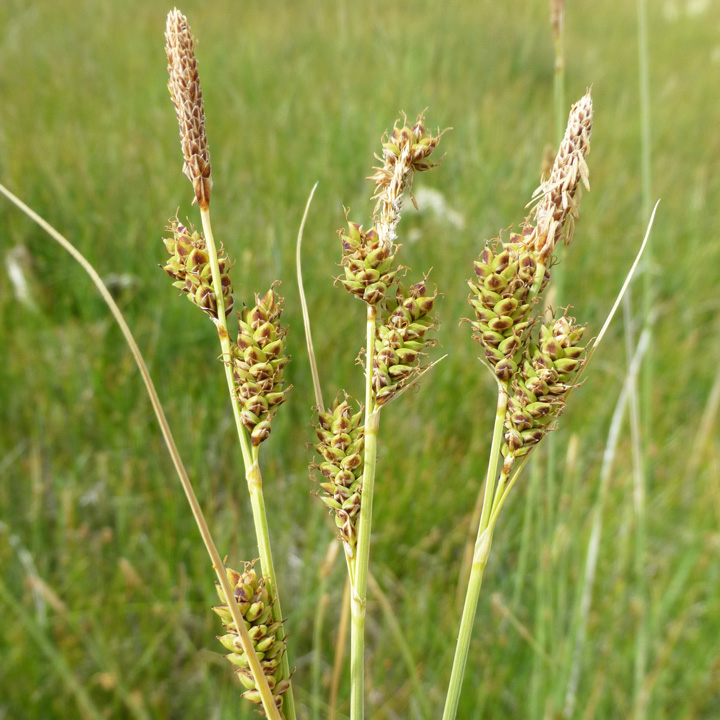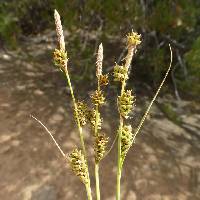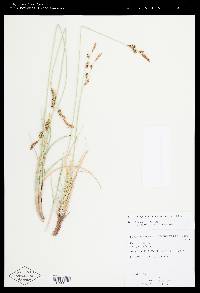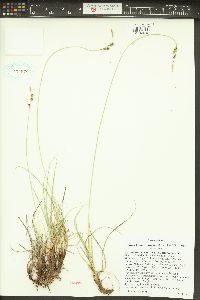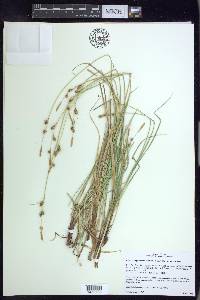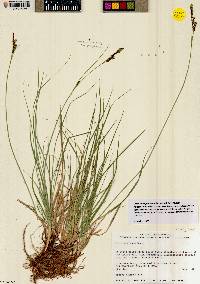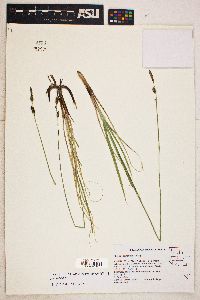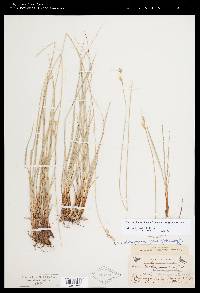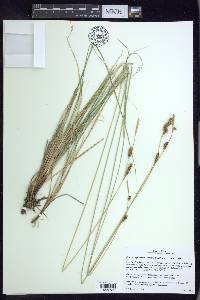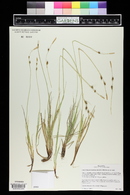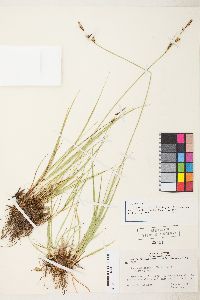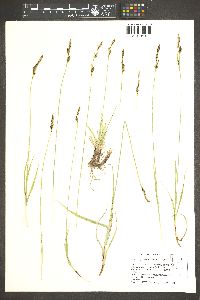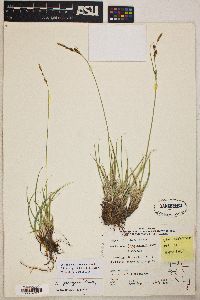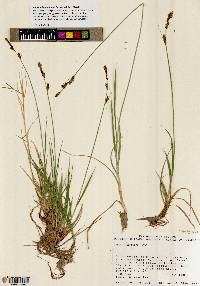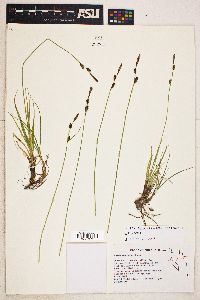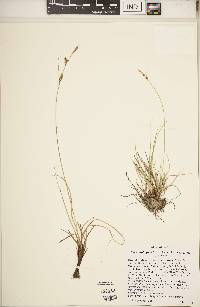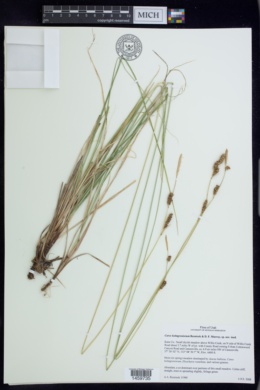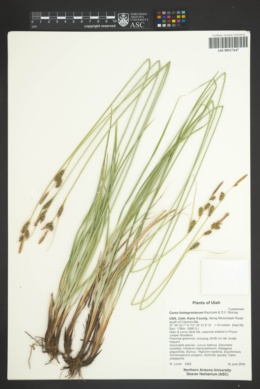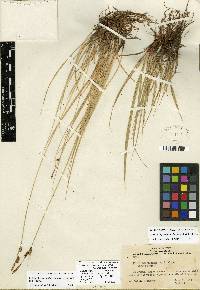
|
|
|
|
Family: Cyperaceae
Holmgrens' Sedge
|
Loosely cespitose from short, ascending rhizomes 2–3.5 mm thick, rhizomes ca. 0.5–2 cm long between shoots, rhizome scales brown, disintegrating into coarse fibers; culms 20 –90 cm tall, stiffly erect, bluntly trigonous, very finely papillose, 0.6–1.1 mm wide immediately below the inflorescence; phyllopodic, cataphylls and basal she aths brown, the youngest usually reddi sh-purple. Leaves ca. 6–12, essentially basal; blades 3.5–48 cm long, 1.5–4 mm wide, much shorter than culms, ±folded, margins and midrib smooth to finely antrorsely scabrous distally, ±smooth adaxially, papillose abaxially; leaf sheaths 1.5–15 cm long, glabrous, ventrally whitish or pale brown, hyaline, thin, concave at the apex; ligules ca. 0.8–5.5(–7.5) mm long, acute to rounded, slig htly shorter than to longer than wide, the free portion wh itish to pale brown. Inflorescences 3–9.5 cm long, with 3–5(–6) spikes, terminal staminate or sometimes gynaecandrous, laterals pistillate; upper lateral spikes ±overlapping, lower somet imes separate, lower two spike s 0.7–4.5 cm di stant, lowermost ± sessile or on a ±smooth peduncle up to 14.2 mm long; lowest bracts ±bristle-like up to 7.5 cm long and 1.5 mm wide, sheathless, upper bracts abruptly reduced. Terminal spike (6.5–)11.5–27 mm long, pistillate portion (0–)2.5–10 mm long, 4.5–7.2 mm wide, ca. (0–)1–28-flowered, staminate portion 4.5–26.5 mm long, 1.8–3.5 mm wide, ca. 10– 65-flowered, peduncle 1.8–38 mm long. Lateral spikes 4–22 mm long, 4–6.8 mm wide, short-cylindric, densely flowered with ca. 5–45 spreading-ascending perigynia. Staminate scales 2.5–4.1 mm long, 1.4–2.4 mm wide, ovate to obovate, reddish-brown with broad hyaline margins, apex obtuse to rounded, with a green, 1–3-nerved center. Pistillate scales 1.6 –2.5 mm long, 1.5–2.2 mm wide, reddish-brown to reddi sh-purple, with broad hyaline margins, broadly ovate to ±circular, obtuse to rounded, green 1–3-nerved center rarely prolonged into a scabrous-ciliate apiculus or awn up to 0.4 mm long. Perigynia 2.5–3.3 mm long, 1.5–2.3 mm wide, rounded trigonous to plumply biconvex, broadly obovate, essentially filled by the achene, coriaceous, finely papillose distally, green to reddish-brown distally, greenish proximally, 2-nerved and sometimes with a few faint ner ves on the faces, rounded-tapering to a ±sessile base, contracted into a well-defined cylindrical beak; beaks 0.25–0.5 mm long, finely papillose and sometimes setulose, green to brown, the apex ±erose to obscurely bidentulate with teeth up to 0.2 mm long. Achenes 1.7–2.4 mm long, 1.3–1.6 mm wide, concavely tapering to a thick stipe 0.1– 0.2 mm long, flattened-trigonous in cross section; convex side s narrowly elliptic to obovate, brown, smooth; apex usually apiculate with an apiculus up to 0.2 mm formed by the persistent style base; style deciduous; stigmas 3. Anthers 3, 1.7–3 mm long, with an apiculus ca. 0.1 mm long. Etymology.—Carex holmgreniorum was chosen to honor Arthur H. Holmgren and Noel and Patricia Holmgren, who together have collected this species several times and whose scholarship has contributed so much to our knowledge of the Intermountain flora. Alkaline seeps, adjacent to springs, riparian zones, moist meadows, pasture land, calcareous and often saline soils, with species such as Juncus balticus Willd., Eleocharis rostellata (Torr.) Torr., and Schoenoplectus pungens (Vahl) Palla. Elevation 1400–2000 m. UNITED STATES. Idaho, Nevada, Utah. Some of the Utah localities of C. parryana mapped by Albee et al. (1988) presumably refer to this species. This is a distinctive species whose lack of recognition was due to its relative rarity and the confusion surrounding the misapplication of the name C. aboriginum. It is easily recognized by its combination of large pistillate lateral spikes, staminate or gynaecandrous terminal spike, broad achenes and perigynia, and pistillate scales distinctly shorter than the perigynia. It is an uncommon and local endemic of the northern Great Basin and western portion of the Colorado Plateau. |

